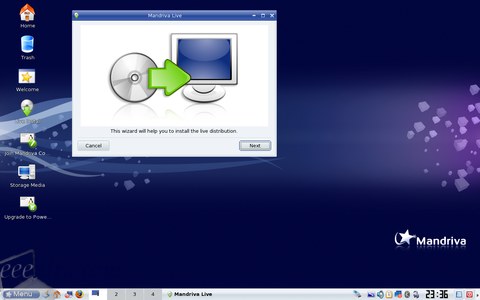
Live USB creation
(with web-search links for finding
|
! Note !
A few more notes may be added,
if/when I re-visit this page again.
In any case, you can use WEB SEARCH links
below to find current information on making
'Live USB' sticks for Linux distros.
|
This page is a guide for creating a 'Live USB' stick of a Linux 'distro'. This description is reproduced from an old blog-like page (now 'dead') that was at http://www.eeextra.com/ linux/ mandriva-linux-one-2008-live-usb-creation.html I reproduced the page here (text & images) for my own use/reference --- as well as to preserve the info for others, in case that site or page disappears (which it indeed did). The requirements are
The guide starts now. My additions and re-wordings (except the most trivial corrections, such as fixing verb tense or substituting a different 2 or 3 letter preposition) are indicated in left-and-right brackets --- namely, [ and ] .
2010 Mar UPDATE: In a Ubuntu Linux 9.10 (Karmic Koala) install (or Live CD try-out), one can use, from the top panel, System > Administration > USB Startup Disk Creator. See web-links at the bottom of this page for alternate methods of making 'Live USB' sticks, for various Linux distros. |
|
START of the 'www.eeextra.com' Guide on how to We will review in this guide how to create a live USB 'key', so we can boot Mandriva 2008 Spring on the Asus EEE PC [or try it on some other 'netbook', like an Acer Aspire One]. Mandriva 2008 is one of the most complete linux distributions, and the [post-beta] version of 'Mandriva One Spring 2008' came out a few days ago, so it is a good occasion to create a live USB to test it on the [Asus] EEE. Mandriva is selling USB disks with the OS pre-installed, and there isn't an easy USB live creator like the one provided with 'eeexubuntu' or 'eeepclinuxos' [Linux distros that may come pre-installed on Asus EEE PC's]. The process isn't that hard though, as we will see in this step-by-step guide. [Spoiler alert: It involves using the Mandriva 'DrakX' disk partitioning wizard, initiated from a 'Mandriva Live' GUI interface.]
|

|
[In the live-install GUI interface,] Choose Custom disk partitioning and click next. [See image below.] |
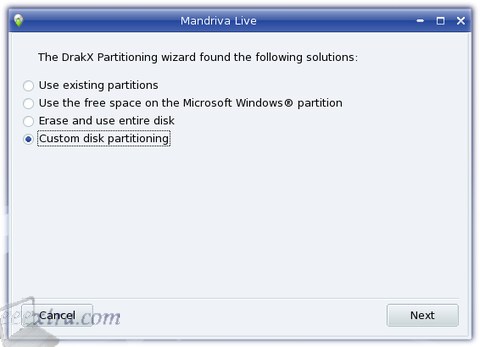
|
Now you have to select your USB key. [See the next screenshot.] On our PC, it was the second tab named sdb. You need a 4GB USB key, or an SDHC card. Before applying the next steps, please be aware of the risks implied, you could end up formating the wrong disk or messing up the mbr [master boot record] of your PC. Select your [USB] disk, click on Delete, and Auto allocate. [See image below.] |
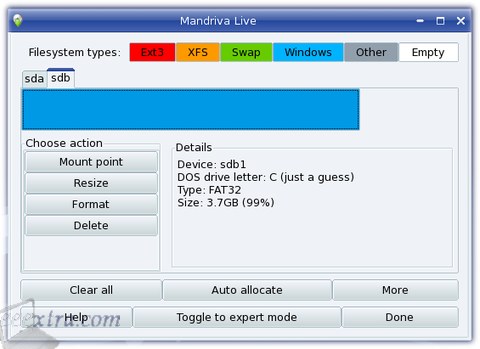
|
Mandriva created an Ext3 partition [on the USB drive] as well as the swap in an automated fashion. [See image below.] |
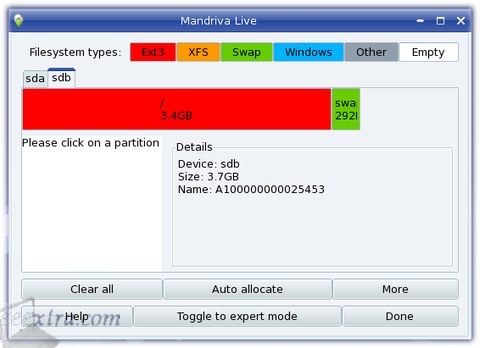
|
[Click Done.] The Live Install will ask for the Bootloader options, as on the picture below. The most important thing is to choose your USB disk ('sdb' in our case). Leave 'Grub with graphical menu'. [See image below.] |
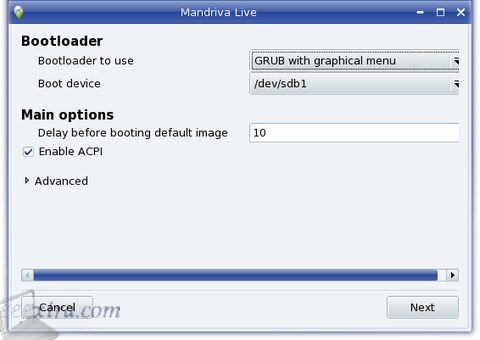
|
Finally, mandriva will ask for the drive you are booting from. Choose the USB disk ['sdb']. See image below. |
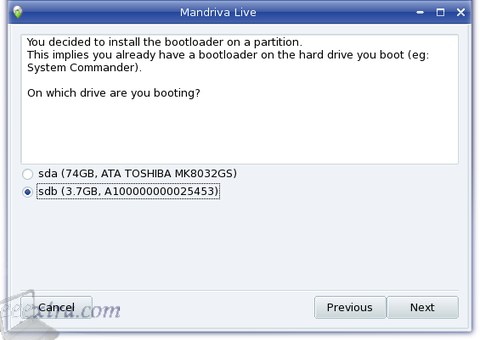
|
You can start the installation. The process was painfully slow (especially when you are impatient to test the distribution), about 35 minutes. As we mentioned in earlier posts, installing 'eeexubuntu' or 'eeepclos' took only about 7 min or so.
Update: [The technique uses the 'unetbootin' GUI utility and a set of several 'fix' files in a tar-gzipped file.]
END of www.eeextra.com Guide on
Note1:
Note2: |
|
Some external links on creating Linux 'Live USB boot drives' : There are some guides on creating 'Live USB boot drives' for many varieties of Linux (Ubuntu, Puppy Linux, etc.) at pendrivelinux.com. There is a 'Linux on a Pendrive HOWTO' (2009) at 'tldp.org'. (TLDP = The Linux Documentation Project) |
|
FOR MORE LIVE-USB (or LIVE-CD) CREATION INFORMATION: To find more information on making 'Live USB' sticks for Linux distros (especially Ubuntu distros), you can try WEB SEARCHES on keywords such as the following. You can also try Wikipedia pages like the following, and following links on those pages for even more information. Wikipedia page - 'List of tools to create Live USB systems' Wikipedia page - 'List of live CDs'
Wikipedia page - 'UNetbootin'
Wikipedia page - 'Fedora_Media_Writer' |
|
Bottom of this To return to a previously visited web page location, click on the Back button of your web browser, a sufficient number of times. OR, use the History-list option of your web browser. OR ...
< Go to Top of Page, above. >Page history:
Page was created 2009 Aug 07. |